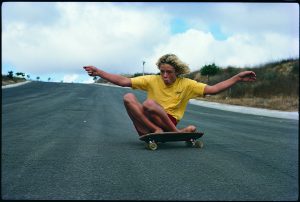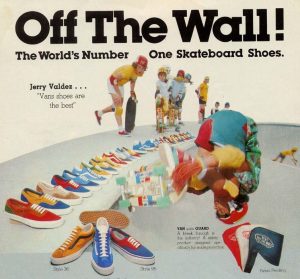San Leandro, CA – Skate Industry News: Where Did Skate Shoes Come From? and Who Do We Have To Thank?
Posted in: Uncategorized

While early skateboarders generally rode barefoot, preferring direct foot-to-board contact, and some skaters continue to do so, one of the early leading trends associated with the sub-culture of skateboarding itself, was the sticky-soled slip-on skate shoe, most popularized by Sean Penn’s skateboarding character from the film Fast Times at Ridgemont High.
Because early skateboarders were actually surfers trying to emulate the sport of surfing, at the time when skateboards first came out on the market, many skated barefoot. But skaters often lacked traction, which led to foot injuries. This necessitated the need for a shoe that was specifically designed and marketed for skateboarding, such as the Randy “720”, manufactured by the Randolph Rubber Company, and Vans sneakers, which eventually became cultural iconic signifiers for skateboarders during the 1970s and ’80s.
 While the skate shoes design afforded better connection and traction with the deck, skateboarders themselves could often be identified when wearing the shoes, with Tony Hawk once saying, “If you were wearing Vans shoes in 86, you were a skateboarder”. Because of its connection with skateboarding, Vans financed the legendary skateboarding documentary Dogtown and Z-Boys and was the first sneaker company to endorse a professional skateboarder Stacy Peralta. Vans has a long history of being a major sponsor of many of skateboarding’s competitions and events throughout skateboarding’s history as well, including the Vans Warped Tour and the Vans Triple Crown Series.
While the skate shoes design afforded better connection and traction with the deck, skateboarders themselves could often be identified when wearing the shoes, with Tony Hawk once saying, “If you were wearing Vans shoes in 86, you were a skateboarder”. Because of its connection with skateboarding, Vans financed the legendary skateboarding documentary Dogtown and Z-Boys and was the first sneaker company to endorse a professional skateboarder Stacy Peralta. Vans has a long history of being a major sponsor of many of skateboarding’s competitions and events throughout skateboarding’s history as well, including the Vans Warped Tour and the Vans Triple Crown Series.
As it eventually became more apparent that skateboarding had a particular identity with a style of shoe, other brands of shoe companies began to specifically design skate shoes for functionality and style to further enhance the experience and culture of skateboarding including such brands as; Converse, Nike, DC Shoes, Globe, Adidas, etc.
Many professional skateboarders are designed a pro-model skate shoe, with their name on it, once they turn pro. Some shoe companies involved with skateboarding, like Sole Technology, an  American footwear company that makes the Etnies skate shoe brand, further distinguish themselves in the market by collaborating with local cities to open public Skateparks, such as the Etnies skatepark in Lake Forest, California.
American footwear company that makes the Etnies skate shoe brand, further distinguish themselves in the market by collaborating with local cities to open public Skateparks, such as the Etnies skatepark in Lake Forest, California.
Skate shoes have come a long way, and in some ways stayed true to the roots of what those early surfers wanted. Comfort, usability, and best of all…. style.
Return to: San Leandro, CA – Skate Industry News: Where Did Skate Shoes Come From? and Who Do We Have To Thank?
Social Web